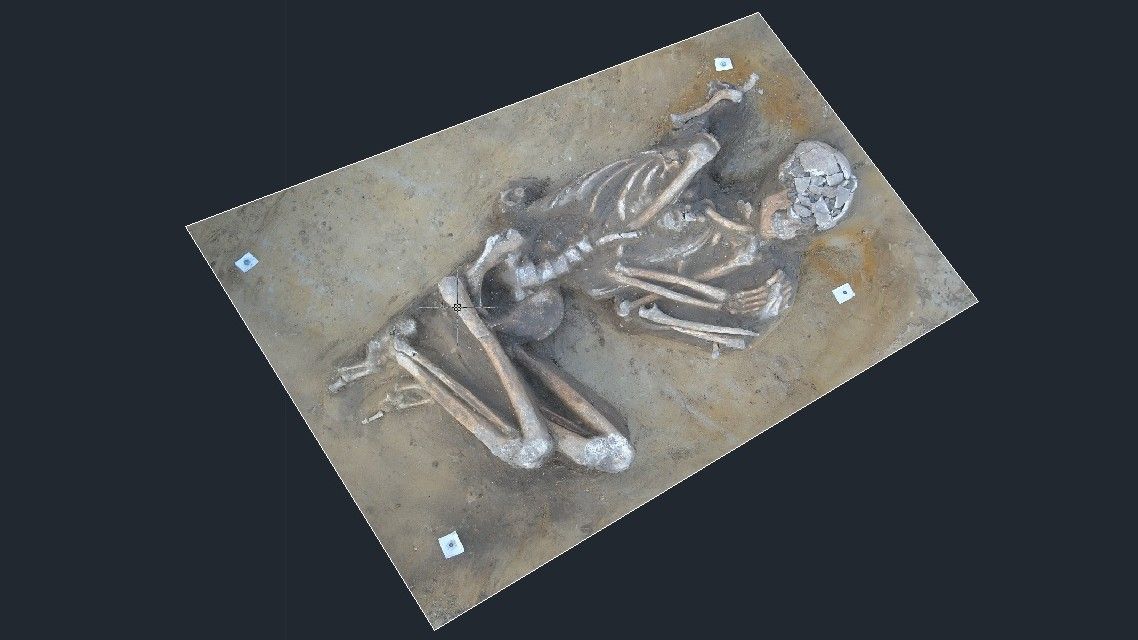Dobré počtení, díky 
A perfectly preserved skeleton of an early farmer in Poland
Categories: Nálezy nejenom s detektorem kovů ve východní Evropě

Archaeologists near Krakow have discovered a 7,000-year-old complete human skeleton in the fetal position. It was discovered during the renovation of a square in Słomniki together with linear pottery, which made the dating of the grave and the origin of the deceased possible. It is one of the oldest Neolithic graves in Poland, the preservation of the skeleton is quite exceptional.
"The individual was buried in loosely smothered soil that has a non-acidic chemical composition, which helped preserve the skeleton," said lead archaeologist Paweł Micyk of Galty Earth & Engineering Services. "We were expecting to find the remains of medieval city walls, perhaps the remains of the city's early days. No one expected us to reach into prehistoric times. At this time we are unable to determine who was buried, although an upcoming anthropological study will likely yield moremore information," Micyk said, adding that radiocarbon analysis is planned for a more precise time frame.
Fragments of flint were also found near the buried person. Some grave goods were damaged because the upper floor of the tomb was leveled sometime in the past for urban construction. Even so, according to Małgorzata Kot, professor of archaeology at Warsaw University, "...this is a really exciting and very important discovery. The skeleton belongs to the earliest Neolithic farmers who crossed the Carpathian Mountains from the south and entered Poland in the 6th millennium BC," she told Live Science.
"We still know little about these early farmers. About their culture and especially their burial practices. They buried their dead either in settlements or in separate burial sites, but these are very rare," Kotova said. "It is possible that the new discovery will bring more information about these people. You have to imagine that these first farmers were entering an absolutely new land that was unknown to them. A land of the deep forests of the Central European lowlands. A land of a harsher climate, but also a land that was already inhabited by other people," Kotová said, adding that they must have encountered hunters and gatherers who already lived there: "Farmers and hunter-gatherers have coexisted for about two millennia, but how they interacted is still not entirely clear," she concluded.
Roman Němec
Sources: archaeology.org, livescience.com, ancient-origins.net, thesciencetimes.com

Skeleton found during reconstruction in Krakow

Location of the find

Location of excavation
The article is included in categories:
- Archive of articles > Archaeology > Finds and rescue research abroad > Nálezy nejenom s detektorem kovů ve východní Evropě
Post
Děkuji za článek  No a nebýt těch štětečkářů,"okradačů detektorářů" ,zdržovačů staveb atd. Tak se ani o něcem tak parádním nedočteme.Já sám jsem nachodil desítky hodin na jednom poli s vltavíny ale až na jedné akci ve spolupráci jsem se dozvěděl že tam byl pokud se nepletu podobně starý a nejvíc zachovaný hrob v Čr.A to jsem po něm chodil.Někteří kluci jsou fakt srdcaři.A výzkum má své opodstatnění.
No a nebýt těch štětečkářů,"okradačů detektorářů" ,zdržovačů staveb atd. Tak se ani o něcem tak parádním nedočteme.Já sám jsem nachodil desítky hodin na jednom poli s vltavíny ale až na jedné akci ve spolupráci jsem se dozvěděl že tam byl pokud se nepletu podobně starý a nejvíc zachovaný hrob v Čr.A to jsem po něm chodil.Někteří kluci jsou fakt srdcaři.A výzkum má své opodstatnění.






